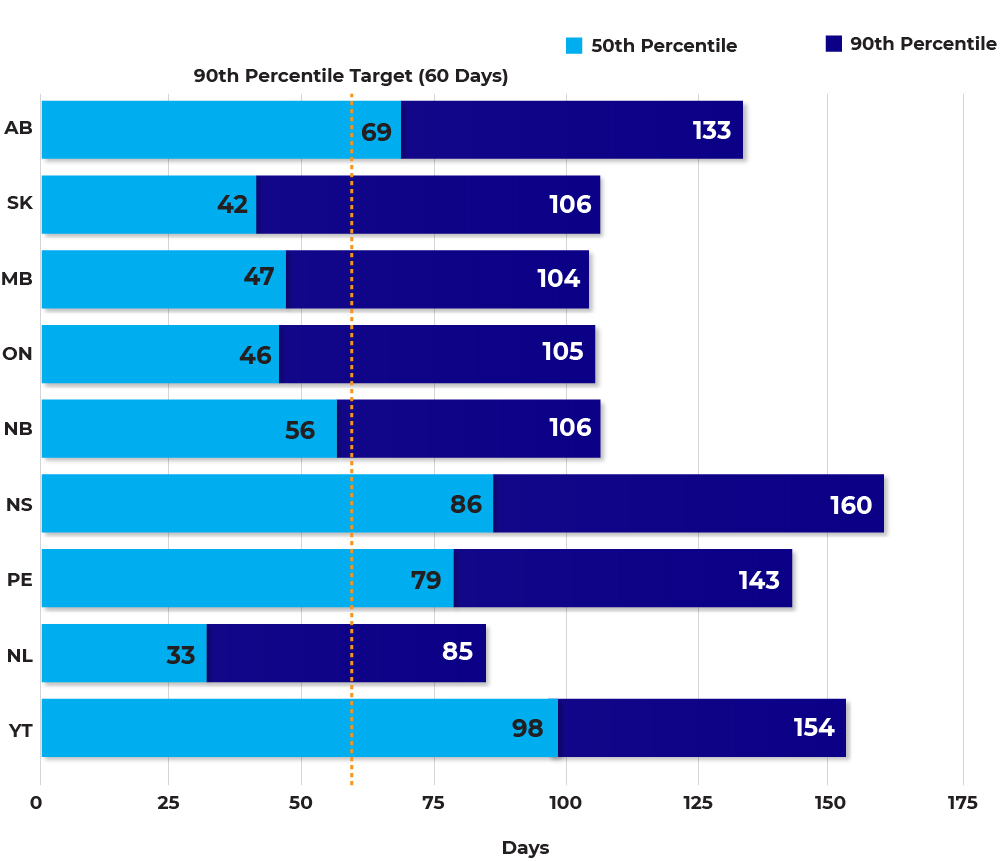Wait time to follow-up colonoscopy
Why is this important? The wait time to follow-up colonoscopy provides information on the effectiveness of the referral system and the availability of the diagnostic procedure. Long wait times to colonoscopy after a positive fecal test can have negative impacts on screening participants by causing unnecessary anxiety and stress, and potentially worse screening outcomes in terms of stage of diagnosis.1 For this indicator, a cut off of 6 months is used because waiting longer than 6 months for follow-up has a significant impact on clinical outcomes and the benefit of screening is greatly reduced.
Indicator definition: The time interval from an abnormal fecal test result to the follow-up colonoscopy.
Target: ≥ 90% of people receive a colonoscopy within 60 days
Indicator calculation: Two different calculations for wait time to follow-up colonoscopy are reported here:
- Percent of people who receive a follow-up colonoscopy within 60 days:
- Numerator: The number of people with an abnormal fecal test lab result who had a follow-up colonoscopy within 60 days of the date of the abnormal lab result.
- Denominator: The number of people with an abnormal fecal test lab result within the measurement timeframe and have a follow-up colonscopy within 6 months.
- Median and 90th percentile number of calendar days from an abnormal fecal test result to a follow-up colonoscopy. Only those colonoscopies that occur within 6 months of the abnormal fecal test are included.
For both calculations, people who have a positive fecal test but did not have a follow-up colonoscopy within 6 months are excluded.
How does 2017/18 compare to 2013/14? Compared with data in the colorectal cancer screening report for 2013-14 where 90% of people waited between 104 – 151 days, almost all jurisdictions who provided data for 2017/18 had shorter wait times to colonoscopy.
Percentage of people who have colonoscopies performed within 60 days of abnormal fecal tests among individuals aged 50-74, by jurisdiction, screening year 2017 – 2018

Text description and footnotes
The percentage of colonoscopies that are performed within 60 days ranged from 10.5% in Yukon to 77.1% in Newfoundland and Labrador. No jurisdiction reached the target of 90%.
Wait time (days) from abnormal fecal test to colonoscopy among individuals aged 50-74, by jurisdiction, screening year 2017 – 2018

Text description and footnotes
Wait times were within 60 days for half of individuals (the median) in Saskatchewan, Manitoba, Ontario, New Brunswick, and Newfoundland and Labrador. No jurisdictions reached the target to have 90% of people (the 90th percentile) wait less than 60 days. Wait times for 90% of people range from 85 days in Newfoundland and Labrador to 160 days in Nova Scotia.
Additional considerations: Wait time to follow-up colonoscopy is likely to be affected by the follow-up colonoscopy uptake rate and other factors, including the participation rate in the screening program, and access and availability of colonoscopy services. This indicator does not count people who receive a follow-up colonoscopy more than 6 months after a positive fecal test as the benefit of screening is significantly reduced if follow-up is delayed for this long.
COVID-19 considerations
![]() During the COVID-19 pandemic, wait times in colorectal cancer screening programs increased as non-emergent health services were paused or reduced. Longer wait times impacted different population groups disproportionately, with older individuals, people with lower neighborhood income level, and people living near First Nations reserves having longer wait times to diagnosis during the COVID-19 pandemic in Ontario.2 Colorectal cancer screening programs will need to monitor wait times closely during the COVID-19 pandemic recovery phase to ensure that all screening participants are able to access follow-up services in a timely manner and develop strategies to reduce disparities between different populations. Longer wait times for a follow-up colonoscopy may lead to more people being diagnosed with colorectal cancer at later stages, which will impact downstream cancer services such as increasing cancer surgeries and the cost of treatment. Programs may consider reducing the colonoscopy backlog by increasing capacity for follow-up colonoscopies and prioritizing people who have waited the longest for a follow-up colonoscopy.
During the COVID-19 pandemic, wait times in colorectal cancer screening programs increased as non-emergent health services were paused or reduced. Longer wait times impacted different population groups disproportionately, with older individuals, people with lower neighborhood income level, and people living near First Nations reserves having longer wait times to diagnosis during the COVID-19 pandemic in Ontario.2 Colorectal cancer screening programs will need to monitor wait times closely during the COVID-19 pandemic recovery phase to ensure that all screening participants are able to access follow-up services in a timely manner and develop strategies to reduce disparities between different populations. Longer wait times for a follow-up colonoscopy may lead to more people being diagnosed with colorectal cancer at later stages, which will impact downstream cancer services such as increasing cancer surgeries and the cost of treatment. Programs may consider reducing the colonoscopy backlog by increasing capacity for follow-up colonoscopies and prioritizing people who have waited the longest for a follow-up colonoscopy.
Reference
1 – Corley DA, Jensen CD, Quinn VP, et al. Association Between Time to Colonoscopy After a Positive Fecal Test Result and Risk of Colorectal Cancer and Cancer Stage at Diagnosis. JAMA. 2017;317(16):1631–1641.
2 – Walker, M.J., Meggatto, O., Gao, J., Espino-Hernandez, G., Jembere, N., et al. Measuring the impact of COVID-19 pandemic on organized cancer screening and diagnostic follow-up care in Ontario, Canada: A provincial, population-based study. Preventive Medicine: 2021. DOI: https://doi.org/10.1016/j.ypmed.2021.106586.
